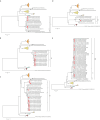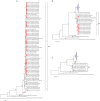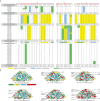Phylogenetic analysis of the viral proteins VP4/VP7 of circulating human rotavirus strains in China from 2016 to 2019 and comparison of their antigenic epitopes with those of vaccine strains
- PMID: 36004332
- PMCID: PMC9393338
- DOI: 10.3389/fcimb.2022.927490
Phylogenetic analysis of the viral proteins VP4/VP7 of circulating human rotavirus strains in China from 2016 to 2019 and comparison of their antigenic epitopes with those of vaccine strains
Erratum in
-
Corrigendum: Phylogenetic analysis of the viral proteins VP4/VP7 of circulating human rotavirus strains in China from 2016 to 2019 and comparison of their antigenic epitopes with those of vaccine strains.Front Cell Infect Microbiol. 2024 Aug 12;14:1455093. doi: 10.3389/fcimb.2024.1455093. eCollection 2024. Front Cell Infect Microbiol. 2024. PMID: 39188418 Free PMC article.
Abstract
Group A rotaviruses (RVAs) are the most common etiological agents of severe acute diarrhea among children under 5 years old worldwide. At present, two live-attenuated RVA vaccines, LLR (G10P[15]) and RotaTeq (G1-G4, G6 P[8], P[5]), have been introduced to mainland China. Although RVA vaccines can provide homotypic and partially heterotypic protection against several strains, it is necessary to explore the genetic and antigenic variations between circulating RVAs and vaccine strains. In this study, we sequenced viral protein VP7 and VP4 outer capsid proteins of 50 RVA strains circulating in China from 2016 to 2019. The VP7 and VP4 sequences of almost all strains showed high homology to those of previously reported human strains and vaccine strains of the same genotype. However, in the presumed antigenic epitopes of the VP7 and VP4, multiple amino acid variations were found, regardless of the G and P genotypes of these strains. Moreover, all circulating G3 RVA strains in China potentially possess an extra N-linked glycosylation site compared with the G3 strain of RotaTeq. The potential N-linked glycosylation site at residues 69-71 was found in all G9 strains in China but not in the G9 strain of the Rotavac or Rotasill vaccine. These variations in antigenic sites might result in the selection of strains that escape the RVA neutralizing-antibody pressure imposed by vaccines. Furthermore, the G4 and P[6] genotypes in this study showed high homology to those of porcine strains, indicating the transmission of G4 and P[6] genotypes from pigs to humans in China. More genetic surveillance with antigenic evaluation in prevalent RVAs is necessary for developing and implementing rotavirus vaccines in China.
Keywords: China; VP4; VP7; antigenic epitopes; diarrhea; rotavirus vaccines.
Copyright © 2022 Mao, Wang, Wang, Ma, Liu, Wang, Sun, Li, Li, Zhang, Li and Duan.
Conflict of interest statement
The authors declare that the research was conducted in the absence of any commercial or financial relationships that could be construed as a potential conflict of interest.
Figures




Similar articles
-
Genetic analyses reveal differences in the VP7 and VP4 antigenic epitopes between human rotaviruses circulating in Belgium and rotaviruses in Rotarix and RotaTeq.J Clin Microbiol. 2012 Mar;50(3):966-76. doi: 10.1128/JCM.05590-11. Epub 2011 Dec 21. J Clin Microbiol. 2012. PMID: 22189107 Free PMC article.
-
VP7 and VP4 genotypes of rotaviruses cocirculating in Iran, 2015 to 2017: Comparison with cogent sequences of Rotarix and RotaTeq vaccine strains before their use for universal mass vaccination.J Med Virol. 2020 Aug;92(8):1110-1123. doi: 10.1002/jmv.25642. Epub 2019 Dec 9. J Med Virol. 2020. PMID: 31774174
-
Comparative characteristics of the VP7 and VP4 antigenic epitopes of the rotaviruses circulating in Russia (Nizhny Novgorod) and the Rotarix and RotaTeq vaccines.Arch Virol. 2015 Jul;160(7):1693-703. doi: 10.1007/s00705-015-2439-6. Epub 2015 May 7. Arch Virol. 2015. PMID: 25944143
-
Circulating rotavirus strains in children with acute gastroenteritis in Iran, 1986 to 2023 and their genetic/antigenic divergence compared to approved vaccines strains (Rotarix, RotaTeq, ROTAVAC, ROTASIIL) before mass vaccination: Clues for vaccination policy makers.Virus Res. 2024 Aug;346:199411. doi: 10.1016/j.virusres.2024.199411. Epub 2024 Jun 3. Virus Res. 2024. PMID: 38823689 Free PMC article. Review.
-
Genetic diversity of G1P[8] rotavirus VP7 and VP8* antigens in Finland over a 20-year period: No evidence for selection pressure by universal mass vaccination with RotaTeq® vaccine.Infect Genet Evol. 2013 Oct;19:51-8. doi: 10.1016/j.meegid.2013.06.026. Epub 2013 Jul 4. Infect Genet Evol. 2013. PMID: 23831933 Review.
Cited by
-
Lipidomics reveals the significance and mechanism of the cellular ceramide metabolism for rotavirus replication.J Virol. 2024 Apr 16;98(4):e0006424. doi: 10.1128/jvi.00064-24. Epub 2024 Mar 15. J Virol. 2024. PMID: 38488360 Free PMC article.
-
Comparative analysis of the RVA VP7 and VP4 antigenic epitopes circulating in Iran and the Rotarix and RotaTeq vaccines.Heliyon. 2024 Jul 4;10(13):e33887. doi: 10.1016/j.heliyon.2024.e33887. eCollection 2024 Jul 15. Heliyon. 2024. PMID: 39071626 Free PMC article.
-
Genomic characterization of the rotavirus G3P[8] strain in vaccinated children, reveals possible reassortment events between human and animal strains in Manhiça District, Mozambique.Front Microbiol. 2023 Jun 5;14:1193094. doi: 10.3389/fmicb.2023.1193094. eCollection 2023. Front Microbiol. 2023. PMID: 37342557 Free PMC article.
-
Genotype analysis of rotaviruses isolated from children during a phase III clinical trial with the hexavalent rotavirus vaccine in China.Virol Sin. 2023 Dec;38(6):889-899. doi: 10.1016/j.virs.2023.11.002. Epub 2023 Nov 14. Virol Sin. 2023. PMID: 37972894 Free PMC article.
-
Human rotavirus strains circulating among children in the capital of China (2018-2022)_ predominance of G9P[8] and emergence ofG8P[8].Heliyon. 2023 Jul 25;9(8):e18236. doi: 10.1016/j.heliyon.2023.e18236. eCollection 2023 Aug. Heliyon. 2023. PMID: 37554825 Free PMC article.
References
Publication types
MeSH terms
Substances
LinkOut - more resources
Full Text Sources
Medical
Research Materials
Miscellaneous

